高中英语现在分词与过去分词作状语的区别
- 格式:ppt
- 大小:1.73 MB
- 文档页数:15
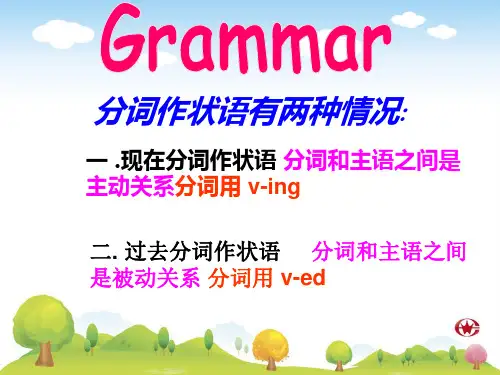


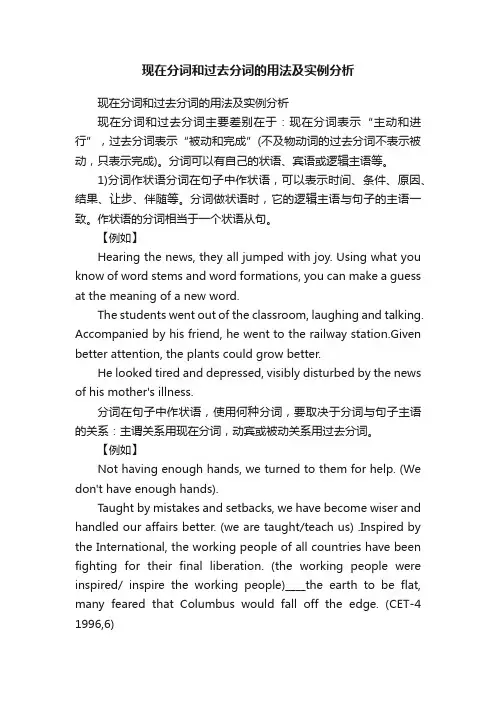
现在分词和过去分词的用法及实例分析现在分词和过去分词的用法及实例分析现在分词和过去分词主要差别在于:现在分词表示“主动和进行”,过去分词表示“被动和完成”(不及物动词的过去分词不表示被动,只表示完成)。
分词可以有自己的状语、宾语或逻辑主语等。
1)分词作状语分词在句子中作状语,可以表示时间、条件、原因、结果、让步、伴随等。
分词做状语时,它的逻辑主语与句子的主语一致。
作状语的分词相当于一个状语从句。
【例如】Hearing the news, they all jumped with joy. Using what you know of word stems and word formations, you can make a guess at the meaning of a new word.The students went out of the classroom, laughing and talking. Accompanied by his friend, he went to the railway station.Given better attention, the plants could grow better.He looked tired and depressed, visibly disturbed by the news of his mother's illness.分词在句子中作状语,使用何种分词,要取决于分词与句子主语的关系:主谓关系用现在分词,动宾或被动关系用过去分词。
【例如】Not having enough hands, we turned to them for help. (We don't have enough hands).Taught by mistakes and setbacks, we have become wiser and handled our affairs better. (we are taught/teach us) .Inspired by the International, the working people of all countries have been fighting for their final liberation. (the working people were inspired/ inspire the working people)____the earth to be flat, many feared that Columbus would fall off the edge. (CET-4 1996,6)A) Having believed B) Believing C) Believed D) Being believed本句意思为:相信地球是平的,许多人担心哥伦布会从边上掉下去。
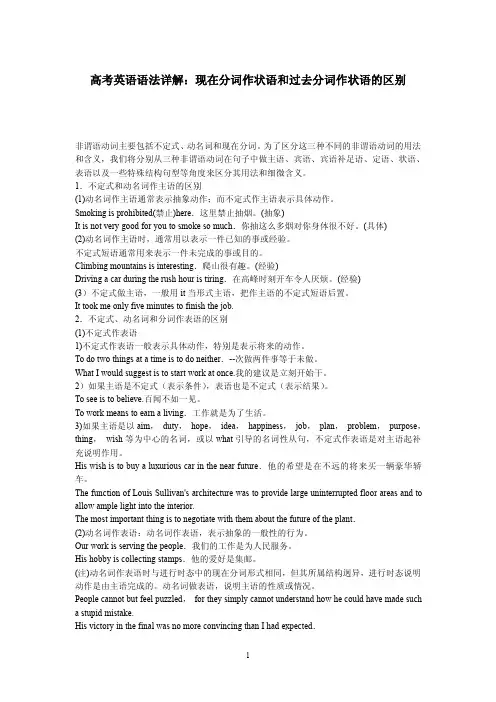
高考英语语法详解:现在分词作状语和过去分词作状语的区别非谓语动词主要包括不定式、动名词和现在分词。
为了区分这三种不同的非谓语动词的用法和含义,我们将分别从三种非谓语动词在句子中做主语、宾语、宾语补足语、定语、状语、表语以及一些特殊结构句型等角度来区分其用法和细微含义。
1.不定式和动名词作主语的区别(1)动名词作主语通常表示抽象动作;而不定式作主语表示具体动作。
Smoking is prohibited(禁止)here.这里禁止抽烟。
(抽象)It is not very good for you to smoke so much.你抽这么多烟对你身体很不好。
(具体)(2)动名词作主语时,通常用以表示一件已知的事或经验。
不定式短语通常用来表示一件未完成的事或目的。
Climbing mountains is interesting.爬山很有趣。
(经验)Driving a car during the rush hour is tiring.在高峰时刻开车令人厌烦。
(经验)(3)不定式做主语,一般用it当形式主语,把作主语的不定式短语后置。
It took me only five minutes to finish the job.2.不定式、动名词和分词作表语的区别(1)不定式作表语1)不定式作表语一般表示具体动作,特别是表示将来的动作。
To do two things at a time is to do neither.--次做两件事等于未做。
What I would suggest is to start work at once.我的建议是立刻开始干。
2)如果主语是不定式(表示条件),表语也是不定式(表示结果)。
To see is to believe.百闻不如一见。
To work means to earn a living.工作就是为了生活。
3)如果主语是以aim,duty,hope,idea,happiness,job,plan,problem,purpose,thing,wish等为中心的名词,或以what引导的名词性从句,不定式作表语是对主语起补充说明作用。
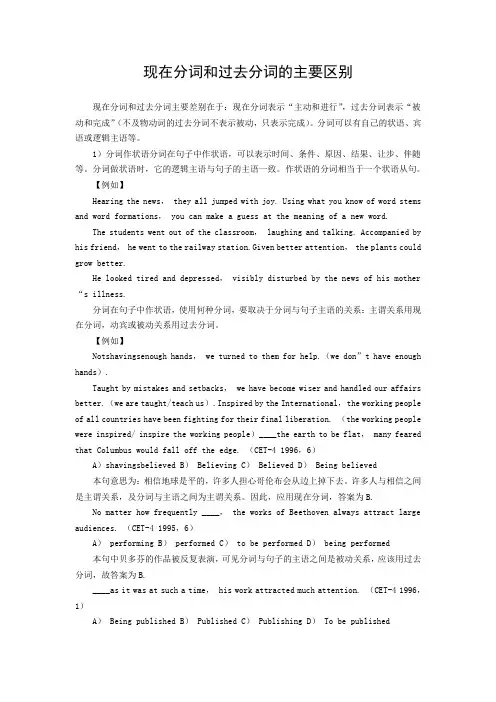
现在分词和过去分词的主要区别现在分词和过去分词主要差别在于:现在分词表示“主动和进行”,过去分词表示“被动和完成”(不及物动词的过去分词不表示被动,只表示完成)。
分词可以有自己的状语、宾语或逻辑主语等。
1)分词作状语分词在句子中作状语,可以表示时间、条件、原因、结果、让步、伴随等。
分词做状语时,它的逻辑主语与句子的主语一致。
作状语的分词相当于一个状语从句。
【例如】Hearing the news, they all jumped with joy. Using what you know of word stems and word formations, you can make a guess at the meaning of a new word.The students went out of the classroom, laughing and talking. Accompanied by his friend, he went to the railway station.Given better attention, the plants could grow better.He looked tired and depressed, visibly disturbed by the news of his mother “s illness.分词在句子中作状语,使用何种分词,要取决于分词与句子主语的关系:主谓关系用现在分词,动宾或被动关系用过去分词。
【例如】Notshavingsenough hands, we turned to them for help.(we don”t have enough hands).Taught by mistakes and setbacks, we have become wiser and handled our affairs better. (we are taught/teach us) .Inspired by the International, the working people of all countries have been fighting for their final liberation. (the working people were inspired/ inspire the working people)____the earth to be flat, many feared that Columbus would fall off the edge. (CET-4 1996,6)A)shavingsbelieved B) Believing C) Believed D) Being believed本句意思为:相信地球是平的,许多人担心哥伦布会从边上掉下去。



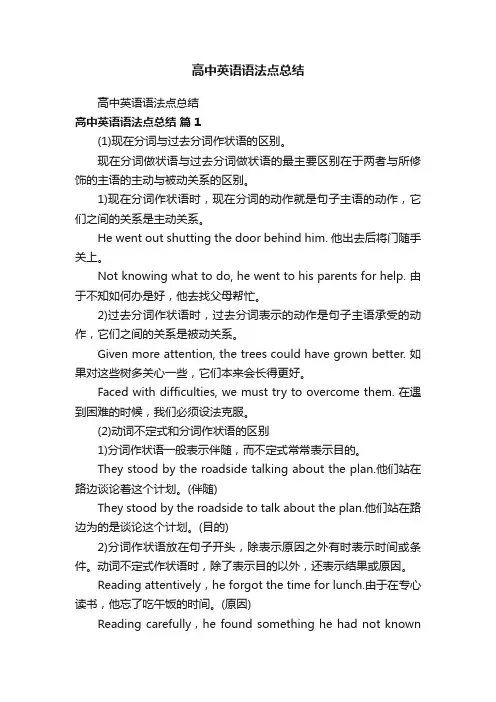
高中英语语法点总结高中英语语法点总结高中英语语法点总结篇1(1)现在分词与过去分词作状语的区别。
现在分词做状语与过去分词做状语的最主要区别在于两者与所修饰的主语的主动与被动关系的区别。
1)现在分词作状语时,现在分词的动作就是句子主语的动作,它们之间的关系是主动关系。
He went out shutting the door behind him. 他出去后将门随手关上。
Not knowing what to do, he went to his parents for help. 由于不知如何办是好,他去找父母帮忙。
2)过去分词作状语时,过去分词表示的动作是句子主语承受的动作,它们之间的关系是被动关系。
Given more attention, the trees could have grown better. 如果对这些树多关心一些,它们本来会长得更好。
Faced with difficulties, we must try to overcome them. 在遇到困难的时候,我们必须设法克服。
(2)动词不定式和分词作状语的区别1)分词作状语一般表示伴随,而不定式常常表示目的。
They stood by the roadside talking about the plan.他们站在路边谈论着这个计划。
(伴随)They stood by the roadside to talk about the plan.他们站在路边为的是谈论这个计划。
(目的)2)分词作状语放在句子开头,除表示原因之外有时表示时间或条件。
动词不定式作状语时,除了表示目的以外,还表示结果或原因。
Reading attentively,he forgot the time for lunch.由于在专心读书,他忘了吃午饭的时间。
(原因)Reading carefully,he found something he had not knownbefore.他仔细读书时,发现了一些从前不知道的东西。
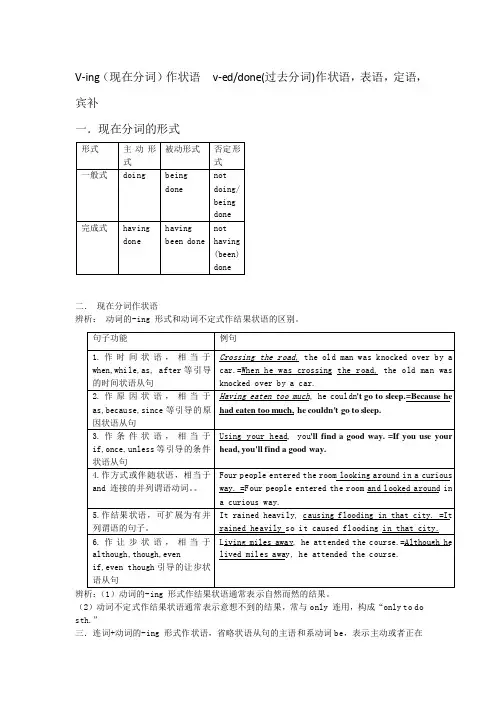
V-ing (现在分词)作状语v-ed/done(过去分词)作状语,表语,定语,宾补一.现在分词的形式形式主动形式被动形式否定形式一般式doing beingdone not doing/beingdone完成式havingdone having been done not having(been)done二.现在分词作状语辨析:动词的-ing 形式和动词不定式作结果状语的区别。
辨析:(1)动词的-ing 形式作结果状语通常表示自然而然的结果。
(2)动词不定式作结果状语通常表示意想不到的结果,常与only 连用,构成“only to do sth.”三.连词+动词的-ing 形式作状语,省略状语从句的主语和系动词be ,表示主动或者正在句子功能例句1.作时间状语,相当于when,while,as,after 等引导的时间状语从句Crossing the road,the old man was knocked over by a car.=When he was crossing the road,the old man was knocked over by a car.2.作原因状语,相当于as,because,since 等引导的原因状语从句Having eaten too much ,he couldn 't go to sleep.=Because he had eaten too much,he couldn't go to sleep.3.作条件状语,相当于if,once,unless 等引导的条件状语从句Using your head,you 'll find a good way.=If you use your head,you'll find a good way.4.作方式或伴随状语,相当于and 连接的并列谓语动词。
Four people entered the room looking around in a curious way.=Four people entered the room and looked around in a curious way.5.作结果状语,可扩展为有并列谓语的句子。
现在分词与过去分词的用法区别现在分词与过去分词的用法区别一、分词的作用1、现在分词可用于:①构成进行时:eg:We are studying English.②当副词作状语:eg:The students came,talking and laughing.③当形容词作定语,宾语和表语:eg:Falling leaves danced in the air.I saw many birds flying along the river.This story is very moving.2、过去分词的作用:①构成完成时:eg:The play had begun when we arrived there.②构成被动语态:eg:English is widely spoken in the world.③当副词作状语:eg:Seen here,the city looks more beautiful.④当形容词作定语,宾语和表语:eg:a boy named tomI saw the girl killed with my own eyes.I am interested in English.二、差别1、在语态上:现在分词表主动,过去分词表被动2、在时态上:现在分词表进行,过去分词表完成三、分词做表语共同点:分词做表语时,起着形容词的作用不同点:分词做表语时,句子的主语就是该分词的逻辑主语。
但现在分词作表语时,与其逻辑主语之间是主动关系;相反,过去分词表被动。
Eg:He looked tired with cooking.He remained standing beside the table.。
现在分词、过去分词作定语、宾语补足语、状语时的区别(一)现在分词\过去分词作定语的区别.The mobile phone lying on the desk belongs to me.=The mobile phone which is lying on the desk belongs to me.(the mobile phone 和lie为主谓关系,即主动关系,故用现在分词)The injured suffering from the shock in the traffic accident were lying in the hospital.=The injured who suffered from the shock in the traffic accident were lying the hospital。
(the injured 和suffer 为主谓关系,即主动关系,故用现在分词)The house built 50 years ago will be pulled soon.=The house which was built 50 years ago will be pulled soon.(the house 和build为动宾关系,即被动关系,故用过去分词)The mobile phone laid on the desk belongs to me.=The mobile phone which is laid on the desk belongs to me.(the mobile phone 和lay 为动宾关系,即被动关系,故用过去分词)小试牛刀:1.The student ________________( speak) to the teacher now is our moniter.2.The problem _______________( discuss) yesterday is of great importance.3.The machine ________________( repair ) yesterday is broken again.4..The guests ________________(invite) to the meeting were all specialists.5.China is a country _______________(belong )to the 3rd world.6 .He lives in the house _______________( face ) the north.7.The temple ________________( stand ) on the top of the hill was built 500 years ago.8.The students ________________( want ) to join the club will gather at the gate.9.The car ____________________(make ) in Japan is of high quality.10.A checking delegation ( 代表团)______________( consist ) of 5 people are visiting our school.A checking delegation ( 代表团)_____________( make) up of 5 people are visiting our school.11. The student________________( focus )on his lesson is best in our class.The student _______________ ( lose )in his lesson is best in our class.12.Can you see the boy _________________ ( dress )in a red shirt?Can you see the boy __________________( wear ) a red shirt?13.The students ____________________( sit ) in Row I see the blackboard clearlyThe students __________________( seat ) in Row I see the blackboard clearly.14. The country _____________ ( lie ) to the east of Shandong Peninsula (半岛) is South Korea.The country _____________(locate ) to the east of Shandong Peninsula (半岛) is South Korea.( 辅助信息:Our school is located in the centre of the town)(二)现在分词、过去分词作宾语补足语的区别find ,make,feel,keep,leave,have ,see,observe,notice,watch,hear 。
现在分词与过去分词的用法区别
一、分词的作用
1、现在分词可用于:
构成进行时:eg:We are studying English.
当副词作状语:eg:The students came,talking and laughing.
当形容词作定语,宾语和表语:eg:Falling leaves danced in the air.
I saw many birds flying along the river.
This story is very moving.
2、过去分词的作用:
构成完成时:eg:The play had begun when we arrived there.
构成被动语态:eg:English is widely spoken in the world.
当副词作状语:eg:Seen here,the city looks more beautiful.
④当形容词作定语,宾语和表语:eg:a boy named tom
I saw the girl killed with my own eyes.
I am interested in English.
二、差别
1、在语态上:现在分词表主动,过去分词表被动
2、在时态上:现在分词表进行,过去分词表完成
三、分词做表语
共同点:分词做表语时,起着形容词的作用
不同点:分词做表语时,句子的主语就是该分词的逻辑主语。
但现在分词作表语时,与其逻辑主语之间是主动关系;相反,过去分词表被动。
Eg:He looked tired with cooking.
He remained standing beside the table.。